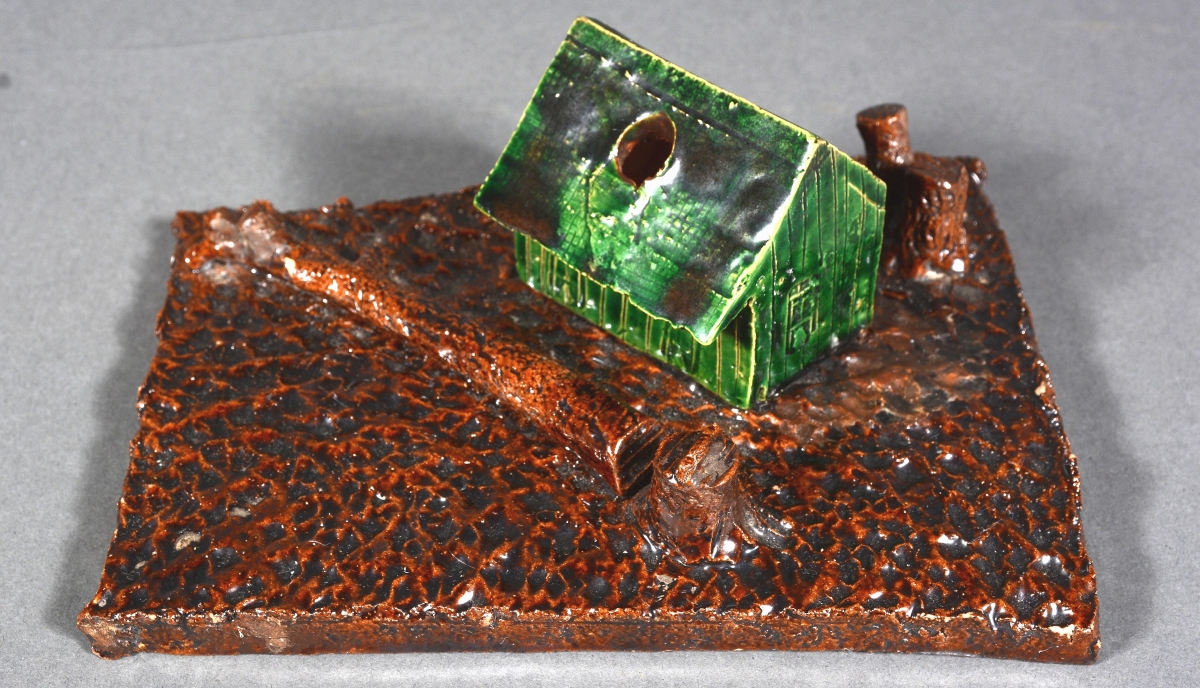
The sale’s leader was found in George Ohr’s cabin inkwell, which sold for $4,875. The cabin inkwell was a standard form for Ohr and others are known in variations of trees and glazes.
Review by Greg Smith, Catalog Photos Courtesy Slotin Folk Art Auction
BUFORD, GA. – Folk art pottery was fired through the block at Slotin Folk Art Auction’s February 13 sale as 327 lots of whimsical Southern clay were offered in the firm’s one-day extravaganza. Each lot was offered without reserve and all sold with a $100,000 total tally, auctioneer Steve Slotin said.
Collectors of contemporary Southern folk art pottery are never content with a single piece, the auctioneer noted. “They’re heavy collectors. When you go in their houses, it’s not just one or two pieces. It’s usually many multiples of that by many potters.”
The vast sea of forms explored by these clay artists makes it an easy endeavor to get caught up in. The sheer amount of face jugs in this sale, each like a different character in a cartoon that plays out on a shelf, makes for a dialogue that is universally appealing, even to non-collectors.
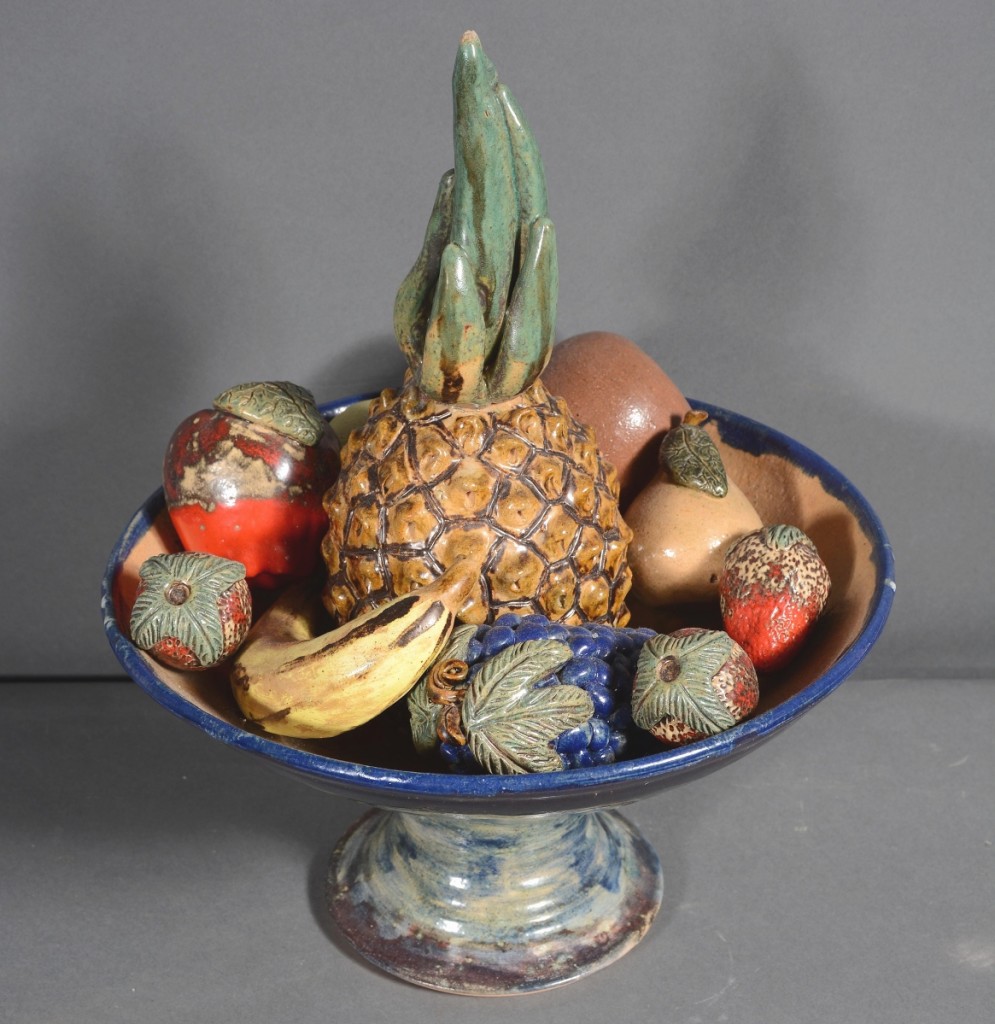
From North Carolina potter Billy Ray Hussey came this scrumptious fruit bowl, which sold for $2,750. The result was the best for any North Carolina potter in the sale. Hussey works out of a wood fired kiln in Bennett, where he creates earthenware works with salt and alkaline glazes, many inspired by historic Southern pottery forms.
“We see a lot of collectors who focus on face jugs,” Slotin said. “Others who focus on utilitarian ware, that is early Southern pottery. We have others who are looking for odd stuff, like animals or unusual items.”
Slotin said that much of the material hailed from potters in Georgia and North Carolina, though other Southern states were represented.
From a Las Vegas collector’s estate came works by Biloxi, Miss., master potter George Ohr.
“Ohr is kind of the pinnacle of a Southern folk potter,” Slotin said. “I know he’s mostly sold in the art pottery world, but just his extraordinary life and behavior, his methods, he really was one of the best Southern artists there ever was.”
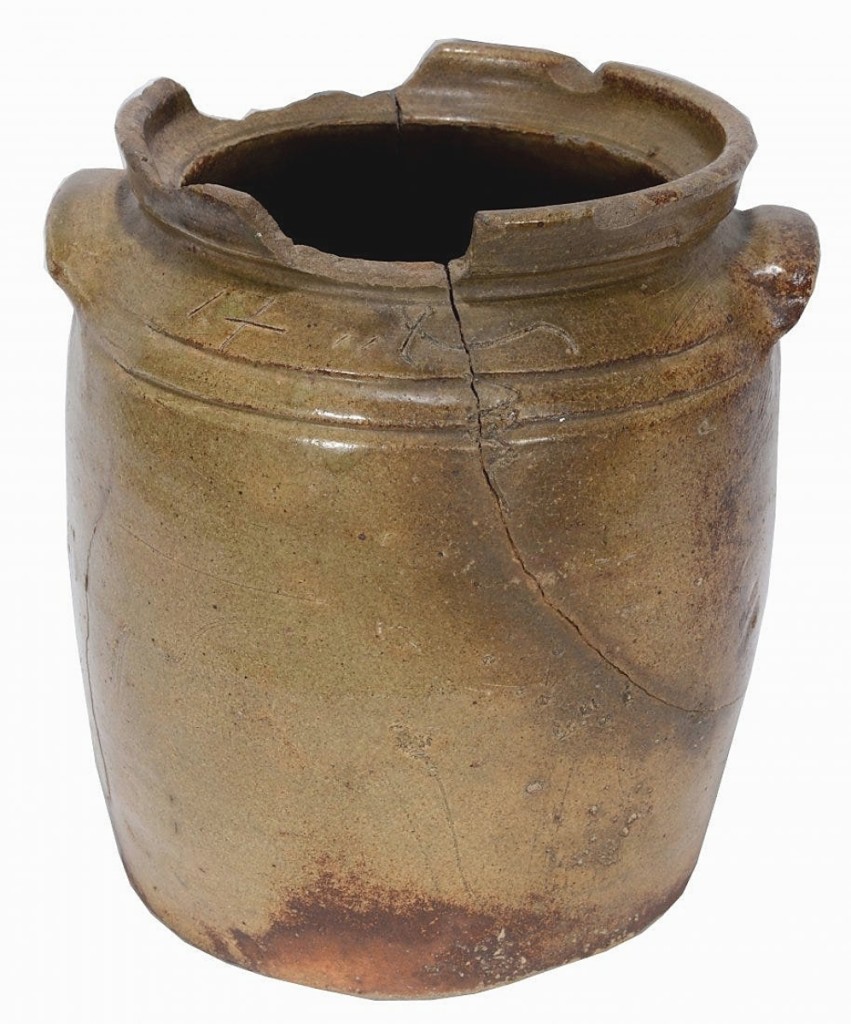
It had losses and cracks, but it was by Dave Drake during his time at the Lewis Miles Pottery. This 2-gallon jar went out at $2,500.
Leading the sale was Ohr’s multi-glaze log cabin inkwell measuring 7 inches across the platform that brought $4,875. The green glazed cabin stood before a downed tree on a brown-red plane. An ash tray measuring 4½ inches wide was signed in script to the bottom and brought $3,250. With no bottom at all was a mysterious 5½-inch-high pitcher in a metallic glaze that sold for $3,125. Rarely appearing at auction was one of Ohr’s price tags or business card-like works: a 3½-inch wide plaque punched with two holes that featured a poem he wrote titled “A Biloxi Welcome.” It read, “The poet sings in dainty rhyme, / Of summer days and sunny clime, / Of beauteous maidens passing fair, / With witching eye and waiving hair / Till near the end you’re to C / A welcome to the pot-Ohr-E. / Resp’y, / GEORGE E. OHR.” The tag sold for $375. Pressed with the potter’s lewd humor were five double-sided brothel tokens in unfired clay that sold for $2,500.
From Ellen J. Lippert’s George Ohr: Sophisticate and Rube, the author notes six different known variations of the double-sided token with 12 pictographic phrases that range from “A Screwing Match” to “You have a fine pair of balls.” Not far from Biloxi was New Orleans and its famed Storyville, which Lippert notes was the United States’ first experiment in legalized prostitution that began in 1889, right in the middle of Ohr’s 30-year production. Tokens used by the Storyville brothels, which were redeemed for services, provided the genesis of the form for the potter. Though Lippert noted Ohr’s tokens were not official currency in use by any establishment, instead “intended to take advantage of the unique tourist trade that this culturally and historically significant destination attracted.”
“Each piece went to a different collector,” Slotin said of the Ohr works. “There was good competition on those. Half the people were local, they picked them up after the sale.”
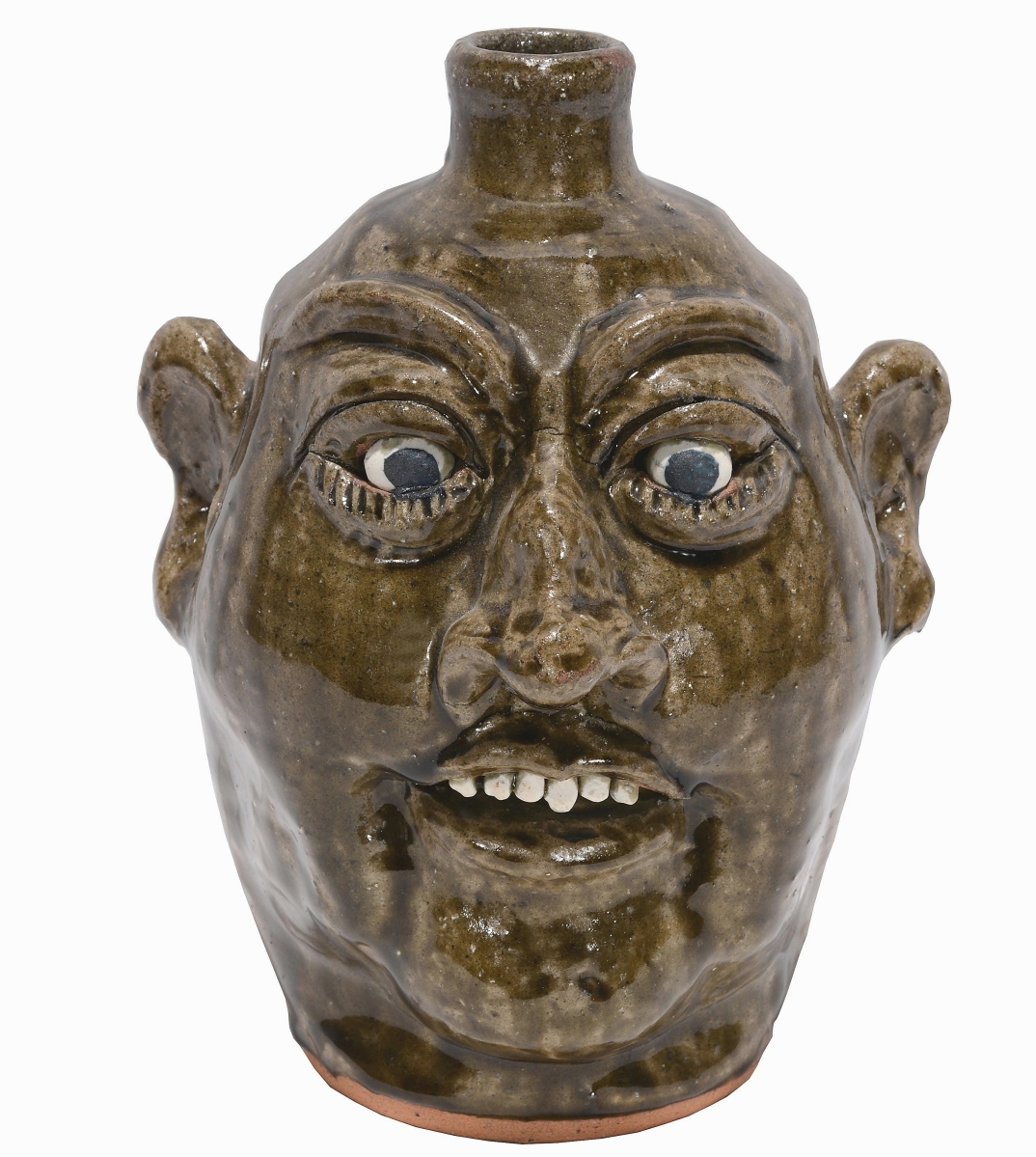
Lanier Meaders’ top work in the sale was a 1988 face jug that brought $2,125. It measured 10 inches high and was in mint condition.
North Carolina potters were represented by Billy Ray Hussey in a $2,750 result for a fruit bowl measuring 15 inches high from the foot to the top of the pineapple stem. The bowl also included a bushel of grapes, a banana and a number of strawberries. Behind at $1,625 was a face jug from Burlon “B.B.” Craig (1914-2002) that measured 9½ inches high in an under-fired white glaze. The unique glaze made it a hot commodity, Slotin said. “There was a lot of attention paid to the one-of-a-kind or rare stuff.” Craig ran his pottery of out of Vail, N.C., and used a wood-fired kiln and alkaline glazes, a tradition rooted in the Catawba Valley by German immigrant potters of the Eighteenth Century. A whole gang of seven cats and one owl in an array of colors by Sandy Cole of the North Cole Pottery would go on to produce $1,063.
Georgia was represented by 60 lots from the Meaders family, with Lanier producing a $2,125 result for a mint condition alkaline glaze face jug produced in 1988 and measuring 10 inches high. Four other Lanier Meaders face jugs would sell around the $1,000 mark. Edwin Meaders was represented by two examples of his iconic cobalt blue rooster, which went out next to each other at $1,500 and $1,375. A group of 15 rooster planters from John Meaders brought $1,063. AG Meaders had two face jugs in a striking tobacco-spit glaze ascend to $750.
“It was good to see AG bring those prices,” Slotin said. “He and a few others were bringing just as much as Lanier.”
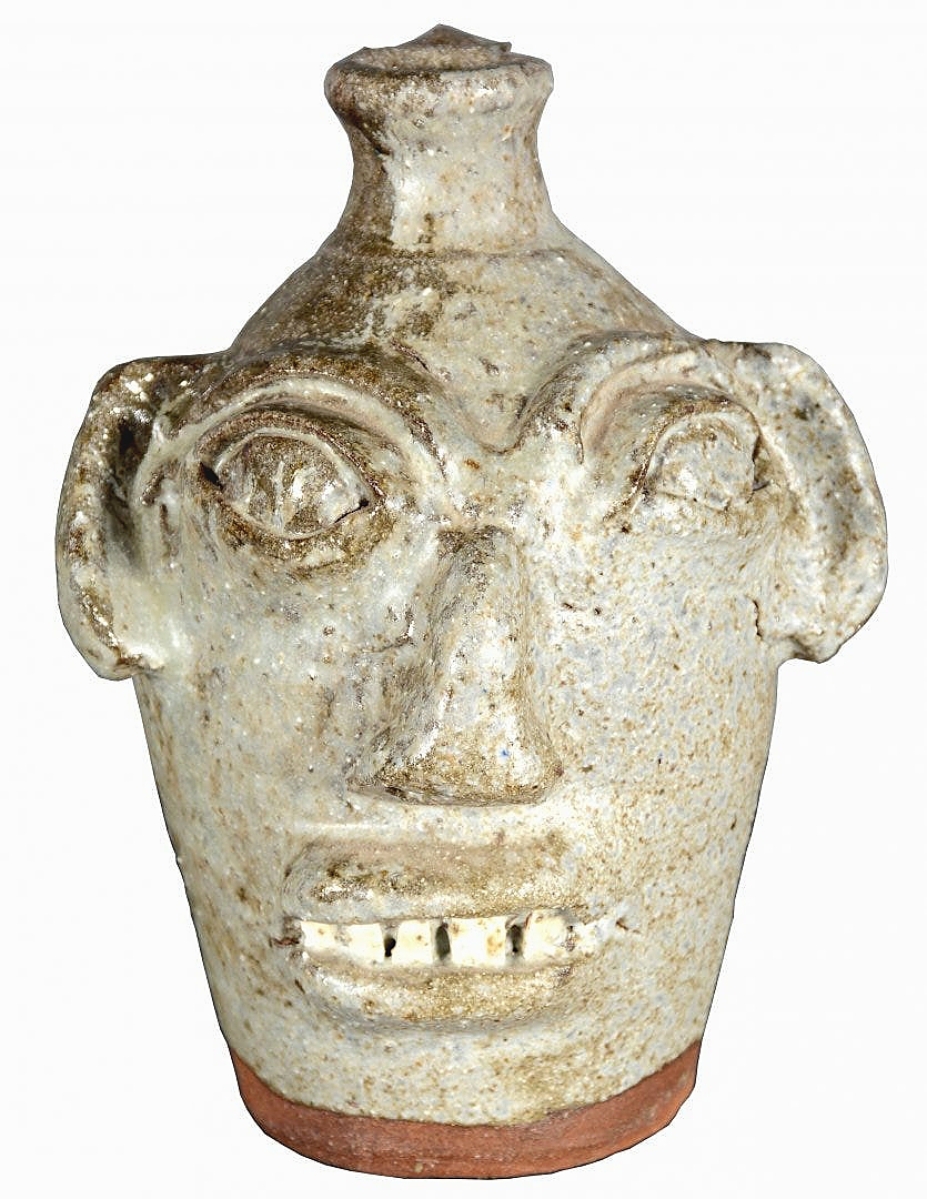
An underfired white/gray glaze pushed interest on a face jug by Burlon Craig. It brought $1,625 on a $500 high estimate.
Lighting up to $1,063 was a face jug lamp by North Georgia maker Roger Corn. Another maker out of Georgia was Marie Rogers, who found good interest in her two-color swirl-glazed face jugs, which brought $750 and $500. Group lots with as many as 14, 11 or nine pieces sold anywhere from $813 to $938.
“For a while, Marie Rogers was a little soft,” Slotin said. “She’s one of the few female potters, but her prices peaked up a bit. She was getting good response.”
From Edgefield, S.C., came a withered survivor in a Dave Drake 2-gallon crock that brought $2,500. The jar marked LM, for the Lewis Miles Pottery, had cracks and losses and the auction house said it was found in an African American neighborhood.
While the sale was entirely online and by phone/absentee, Slotin said he saw good interest and strong participation across the board. The firm has future sales on March 13 and April 24.
All prices include buyer’s premium. For information, 770-532-1115 or www.slotinfolkart.com.






















